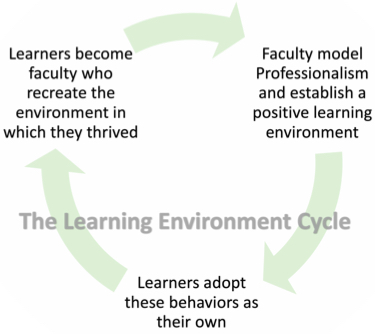Contribute to a Culture of Respect
Faculty model professionalism & set a positive learning environment ----> Learners adopt these behaviors as their own----> Learners become faculty who support the culture of respect

Encourage a Growth Mindset
Learners who adopt a growth versus a fixed mindset about their own personal and professional development are less likely to become frustrated, resist feedback, or quit, and more likely to experience resilience and have long-term success. If you encourage your learners to be metacognitive, to think about how they are thinking about their approach to learning, your attempts to teach them will likely be more effective. And what about you as a learner? Do you have a growth or fixed mindset?
Integrate Practical Ways to Meet Learners’ Needs
Print-and-Go: Best Practices Tip Sheet: Learning Environments
| Domain |
Practical Ways to Meet this Need |
| Physiological |
- Recognize when learners need food or water. Show them where they can put their lunch/buy food
- Provide snacks or a beverage break
- Give bathroom breaks
- Respect duty hours and make sure they are followed
- Acknowledge when learners seem compromised by fatigue or stress. Ask “how are you right now?”
|
| Safety |
- Show learners where they can safely put their belongings
- Make sure learners can get home safely
- Make sure your learners are trained on ALL required safety protocols. Don’t put learners in dangerous situations
- Create an environment where it’s okay to ask questions
- When asking questions, start with easy ones. Ease up to harder questions
- Use buzz groups or think-pair-share to make group questioning safe. Let learners “phone a friend”
- Admit when and what you don’t know
- Communicate clear expectations
|
| Belongingness |
- Always ask learners their name! Find ways to remember them; Let learners know your name and how they can reach you
- Reach out to learners before the start of a class or rotation. Tell them where to go day one, what time to arrive, what to bring.
- Provide a one-page information guide/cheat sheet with key information
- Take 5 or 10 minutes to orient learners; Introduce learners to key individuals; Show learners where they can do their work
- Make learners feel useful and valuable by assigning roles and tasks appropriate to skill level
- Ask learners their short and or long-term goals and how they best learn. Use this information to guide your teaching
|
| Esteem |
- Give positive feedback when it’s deserved
- Give learners tasks or questions at the correct ability level
- Correct wrong answers in a supportive way. Normalize incorrect answers
- Preserve esteem by debriefing after a challenging situation or event
|

